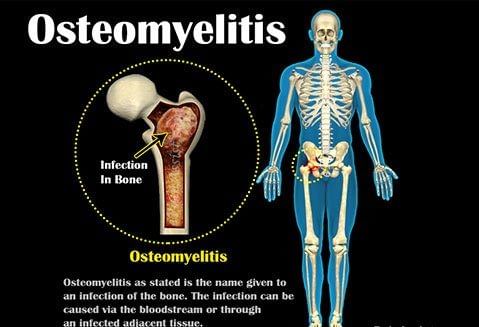Osteomyelitis - Know MOre About It!
Osteomyelitis
Osteomyelitis is the term used for an infection in the bone or bone marrow. The infection is a result of microbes reaching a vulnerable portion of the bone. The infections result in inflammation of the bone causing severe pain and hinders the patient’s healthy functionality of the body region. While the condition is rare, it is very serious and can cause long-term detrimental effects if not treated properly. In this article we’ll explore the various symptoms of Osteomyelitis, to help you identify the problem and also take precautionary steps against it. We have also compiled steps for treatments.
Osteomyelitis is not limited to any specific age group and can affect anyone under certain conditions. In children, it is known to affect growth area bones such as the tailbone of the legs and arms. In adults, the infection can spread to any bone of the body.
Symptoms
In the event that you are uncertain of the possibility of osteomyelitis in your body or that of a family member, here are some symptoms of osteomyelitis you can check for.
- The most common symptom of osteomyelitis is severe pain and redness in the area of infection
- The area may also showcase tenderness in the tissue.
- Irritability and lethargy can suggest the possibility of osteomyelitis in young children if coupled with the possibility of registered pain and redness in the area of infection.
- Fever and chills may also be experienced by the patient as an onset of osteomyelitis.
- The infected area would also be warm with signs of swelling and redness in the early days of the infection.
- Sometimes it may be difficult to identify, due to a lack of visible signs of osteomyelitis or related symptoms, or a challenge of distinguishing the symptoms from other possible problems. In such cases, it is best to schedule a consultation with a specialized physician.
Causes-
- Certain bacteria such as Staphylococcus aureus is known to travel through the bloodstream and can cause a bone infection. The spread of the bacteria through the body can cause infections in multiple areas. Most commonly these bacteria enter the body through the opening of a severe cut or wound. Especially in injuries where the bone breaks and is exposed directly, have a high possibility of developing Osteomyelitis.
- Another prime cause is the possible entrance of the organisms when you are under the knife. Surgeries such as Hip replacements or bone fracture repair can cause such infections. Usually, surgeons take precautions to decontaminate the operating rooms prior to such surgeries. Although in the past Osteomyelitis has been diagnosed in patients who had recently undergone surgery.
- Illness and infections in other parts of the body that have hampered the immune system can lead to Osteomyelitis if the germ like organisms finds the path through the bloodstream to the deeper recesses of bone matter. While several of the organisms that are known to cause Osteomyelitis are present in other parts of the body such as the skin or in the lungs, they are unlikely to find a path to bones in normal conditions. Only in the event that the body is unable to produce the right protection and the organisms are left unchecked can the condition materialize into an infection.
- Patients that use prosthetics can be susceptible to such an infection as amputation sites are vulnerable to osteomyelitis if proper precautions are not taken.
How is it diagnosed?
- In the event that your doctor or physician suspects Osteomyelitis, she may conduct a series of tests to determine the extent and condition of the problem. Sometimes a simple bone x-ray might be sufficient to determine the appropriate course of action for an experienced physician although in certain conditions doctors may need a series of tests conducted.
- A blood-work test is common to identify the organism causing the problem in the bloodstream, in certain cases, a doctor may need to conduct other tests to identify bacteria such as a throat swab test, urine test or stool culture test.
- In more difficult cases the physicians would often conduct detailed scans of the infected area to reveal cellular and metabolic activity levels in the area. MRI scans and bone biopsies are also done for a more detailed look into the area of concern.
Prevention-
- The best prevention is to keep safe against harmful bacteria. Keeping yourself clean and conscious of being in clean areas, will often greatly reduce the possibility of you or a family member contracting an infection. With respect to cuts and deep wounds, make sure to always thoroughly wash the injury under running water, flushing out any bacteria that may have entered the area. Disinfect wounds and properly bandage them with sterile bandages. One must be especially careful with children who have had deep injuries as their bones and immune systems are in the early stages and are more vulnerable to infection.
- If you have a condition of chronic osteomyelitis, make sure to inform your doctor of your medical history and schedule regular visits to keep things in check. For patients with diabetes, be mindful of feet, joints and other bone areas. An early detection of osteomyelitis can be significant in ensuring a speedy recovery through treatment.
- Osteomyelitis prevention can be significant in keeping you and your family members from contracting such infections. It will also ensure you are able to avoid surgeries and possible setbacks caused by infection.
Treatment-
Since Osteomyelitis is a severe condition of infection in bone areas, it requires patients to undergo surgery and medications may be required for several days post surgery. Depending on the situation and severity of the infection, hospitalization of a prolonged period may be recommended by physicians to keep the patient under observation.
The surgery would require a variety of procedures to remove infected or dead portions of the bone. Depending on the severity of the infection, the osteomyelitis surgery can include a mix of the following procedures:
- Removal of fluids that are accumulated in the infected area. This is usually done to reduce swelling by removing pus and other fluids that have accumulated in response to the infection.
- Debridement or removal of bone is a procedure where the surgeon would extract diseased bone. If tissues surrounding the diseased bone also show signs of infection, they may also be removed.
- In the event of a debridement procedure, blood flow will need to restored and surgeons will undertake using tissue from other parts of the body to fill the gap left by the removal of the diseased bone and tissue. The surgeon may also opt to place temporary fillers prior to a bone or tissue grafting procedure that would help restore the damaged tissue and bone matter.
- In some cases, depending on the spread of the infection, doctors may remove surgical plates and screws placed during a previous treatment.
- In severe cases where it isn’t possible to save the infected diseased bone, doctors may be compelled to opt for amputation of the limb to stop the infection from spreading to any other regions of the body.
- In some cases, if the infection is still in a nascent stage and the doctor has identified the bacteria causing the problem, she may recommend antibiotics that would fight the bacteria and thereby limit the need of surgery. While hospitalization might still be needed as these antibiotics will most likely be administered intravenously.
Risk Factors and Complications-
- Since osteomyelitis is an infection of the bone, it can cause reappearances. In most cases, surgery is successful in eliminating the problem although certain cases may be harder to treat.
- Low immune system disorders, severe diabetes or another issue in the blood circulation can cause complication for osteomyelitis treatment.
- Patients with conditions of chronic osteomyelitis need to maintain extra precautions as symptoms of osteomyelitis may have gone but can resurface, sometimes even persist of several years undetected.
- Children and adults over the age of 50 years are susceptible to acute osteomyelitis and should undergo tests and regular consultations with physicians especially if any of the symptoms are being detected. As mentioned earlier, the surest way to fight the problem is to spot it early on and undergo thorough treatment.
Conclusion-
Most cases of osteomyelitis are treatable and subject to the severity may take varied time for the patients to heal. It is often recommended to take to treatment as aggressively as possible to ensure the patient fights off the infection as early as possible. Amputations in worst case scenarios can significantly change a person’s physiological and psychological operations and thereby it’s best to approach cases of osteomyelitis positively from the beginning and ensure all measures are taken to nip the problem in the bud.



+1.svg)
